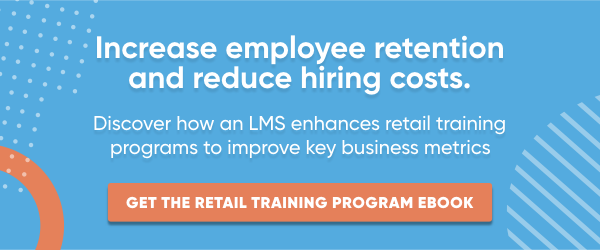The retail sector sees more turnover than any other, except for the technology industry.1 In 2018, one-third of HR and compensation professionals at 53 retailers reported an 81 percent turnover rate among their combined 2 million employees, according to Retail Dive.2
Such a high turnover rate is largely due to the transitory mindset that retail employees take with their positions. They see retail as a short-term, seasonal, or supplementary job until they can land another position.
In a study conducted by the ManPower Group, 74 percent of retail employee participants “were occasionally or often using their computer to look for a new job while on the clock at their current job.”3 Nothing could be a clearer indicator of job dissatisfaction.
The fault isn’t just with workers. Most retail companies fail to take active steps to reduce employee turnover, despite the fact that turnover is expensive in both time and resources. Below are a few basic tips to help you shift your viewpoint and start reducing turnover and ultimately improving performance in your retail business.
.jpg?width=523&name=feedback-3676922_1920%20(1).jpg)
3 Tips for Reducing Employee Turnover in Retail Fields
There are many ways companies can reduce employee churn and its associated costs. You can start your research with other articles and best practices for retaining employees, then supplement your tactics by tailoring tips to the retail field.
Here are a few tips you can start with:
1. Provide effective, progressive training
A contributor to Retail Dive said most company leaders are providing retail training and career pathing in an attempt to retain workers.4 However, employee retention statistics indicate that employee training isn’t putting much of a dent in retail turnover.
Regular training is a key to retaining employees.5 But not just any training will get the job done -- it must be effective, engaging, and specific. The more specific the training, the less likely it is that employees will bolt when challenges arise.6
Most importantly, however, training must be progressive. That means it can’t just end when employees understand how to greet a customer or work a cash register. Progressive training leads employees toward an outcome that’s valuable to them, such as a raise, promotion, or transfer to another department. Progressive training helps retail employees build a career path. A learning management system (LMS) can deliver retail training that meets these standards.
An LMS is a computer software program that delivers, tracks, and reports on training. Online retail training is interactive, customizable, and can be grouped into progressive series of courses that teach more advanced skills over time.
“By using an LMS, company leaders can continuously train employees from their first day on the job to their last. What’s more, an eLearning system can help increase the length of an employee’s time with an organization,” stated 3 Ways an LMS Promotes Employee Retention.
Develop specific “progressions”, or learning paths, that help employees explore areas they’re interested in. You could create a management path that includes leadership training to help associates work their way up, for example.
You could also create paths that teach HR skills, encouraging employees to apply for other positions within your company. Not only does this show employees that you’re investing in them and want them to have a long-term, high-value career with your company, it also helps you staff other departments with employees who understand your products and your customers at the most basic level. That can greatly improve how your company functions, as employees will have a greater understanding of your entire business, instead of just one department.
2. Hire the right employee for the job
When you’re losing employees left and right and need to quickly fill their positions, it can be tempting to not properly screen potential staff to determine if they are truly a good fit for your company. But hiring the right candidates for retail the first time around will really cut down on turnover.
The best candidates probably won’t be over-qualified or under-qualified for the job. They will possess good communication skills, or at least be coachable in this area. Perhaps most importantly, they won’t have an unstable work history. Their resume will indicate they have the ability to stick with a job. This type of job candidate will be an asset, not a liability, to your company.
3. Give applicants a taste of the job before they are onboarded
One of the reasons some retail workers throw in the towel when things get tough is because they don’t expect things to get tough in the first place. Some will apply to your company with no retail experience or expectations about the demands of the job. By using Situational Judgement Tests (SJTs), you can give them an inside look at what they are signing up for before they are recruited.
“An SJT gives your applicants a taste of the job at hand. You can show them exactly what the fun aspects and the not so fun aspects of working at your company are. In the meantime, the data of their input can be used for grading,” stated 7 Reasons for Employee Turnover in Retail.7
This simple action can cut down considerably on turnover by weeding out applicants who aren’t cut out for the job.
Related Reading: Hold Onto Your Employees with a Social Learning Management System.
How Will Your Retail Company Increase Employee Retention This Year?
Retail companies will likely always see significant employee churn, but you can improve your individual company’s reputation and employee retention rate with the right techniques. By training employees with an LMS and providing a clear career path, hiring the right candidates for the job, and letting applicants experience firsthand the demands of the position they are applying for, your organization can get turnover under control.
References:
1. LinkedIn. These 3 industries have the highest turnover rates. https://business.linkedin.com/talent-solutions/blog/trends-and-research/2018/the-3-industries-with-the-highest-turnover-rates.
2, 4. Retail Dive. Retailers are seeing high employee turnover. https://www.retaildive.com/news/retailers-are-seeing-high-employee-turnover/542396/.
3. Small Business. Employee satisfaction studies: managing retail happiness challenge. https://www.thebalancesmb.com/employee-satisfaction-studies-3974977.
5. HR Zone. How regular training can reduce employee turnover. https://www.hrzone.com/talent/development/how-regular-training-can-reduce-employee-turnover.
6. HR Exchange Network. Engagement matters: the impact of training on employee turnover. https://www.hrexchangenetwork.com/learning/columns/engagement-matters-the-impact-of-training-on-emplo.
7. Harver. 7 Reasons for Employee Turnover in Retail. https://harver.com/blog/reasons-for-employee-turnover-in-retail/.







